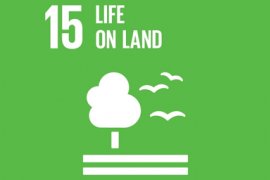Sustainable Land

Human life depends intrinsically on the Earth's land surface, which is becoming increasingly vulnerable as a result of unprecedented degradation, deforestation and biodiversity loss due to land use change, agricultural intensification and climate change.
At the Copernicus Institute we try to understand how environmental change and changing land use affect not only the functioning of the terrestrial ecosystem but also its services to humans. In addition, we evaluate and design governance arrangements so as to mitigate adverse effects and to restore ecosystems and preserve biodiversity of terrestrial ecosystems. We also explore how biofuel production can exist alongside and even benefit food production and biodiversity conservation.
Highlights

Impact of bio-energy production in the USA
The increased demand in biofuels will change how land in the southeast of the United States is being used and managed. This has a major effect on the regional biodiversity. Researchers quantified these land use changes and their effects on the regional biodiversity.

Preventing Indirect Land Use Change
Bioenergy is expected to play an important role in future sustainable and low carbon energy supply. But increased production of crops for bioenergy can trigger potential indirect land use change. This has become a critical point of discussion for the sustainability of bioenergy.

Defaunation, rewilding and ecosystem sustainability
Our planet is currently facing a dramatic and rapid loss of the world’s last wild megafauna. This so-called defaunation may have huge impacts on ecosystems. We investigate its patterns and processes, consequences, and rewilding as the reversal of defaunation.

Protected areas’ location may hinder conservation efforts of giant panda
The introduction of panda to more diverse habitats and foods may promote the conservation of the species.

First Smart Park in Europe
Dutch National Park Zuid-Kennemerland is equipped with a Smart Parks network that gathers information about the behaviour of large grazers.

African savannas affected by how often and how hard it rains during the wet-season
Climate change is expected to increase rainfall across Africa. But how will this affect savannas and grasslands? How can we manage such areas under a changing climate.

New theory unravels social network of trees
How is it possible that so many different tree species live side-by-side in forests? An intriguing question for scientists for decades, researchers have now discovered a way to mathematically describe the social network that creates and maintains biodiversity in forests.

Rabbit dung increases plant biodiversity
The biodiversity of plants is affected by the composition of manure, The composition of rabbit manure, for example, is quite different from that of large grazers.

Balance matters: biodiversity and nutrient stoichiometry
Ecological stoichiometry is about the balance of energy and elements in environment and organisms. In the Anthropocene the balance between the essential elements carbon, nitrogen and phosphorus has been altered. We study the biogeochemical cycling of these nutrients and how changes in the bioavailability and balance affect the persistence or disappearance of plant species.

Wetland Restoration
Wetlands provide 40% of the renewable ecosystem services, despite their global cover of only 6%. However, wetlands are being degraded which endangers the performance of ecosystem services. Our studies enable us to better understand wetland processes and how they function and to design measure and policies to restore them.

Builders on the Beach
This project is a collaboration of Utrecht University and the Royal Netherlands Institute for Sea Research (NIOZ). Within a multidisciplinary team, combining the knowledge of dryland and sandy coastal systems, a novel hypothesis on embryonic dune grass survival is investigated. By better understanding the driving mechanisms behind dune building grasses and there spatial implications, this project wants to contribute to successful nature based solutions for dune restoration and coastal defense.

Research & Education Hub Utrechtse Heuvelrug
The Research & Education Hub Utrechtse Heuvelrug provides a transdisciplinary landscape where researchers, students and societal stakeholders from the area can learn together how to achieve sustainability transitions in a way that protects the natural heritage and the intrinsic, relational and instrumental value of the national park.

Harmonizing human-wildlife coexistence: the WildlifeNL research program
Wild and free-ranging large mammals are increasingly found across parts of the Netherlands. With both positive and negative encounters with the public, society views the return of this wildlife in different ways. A collaboration of 17 diverse organisations, WildlifeNL is investigating how humans and wildlife can learn to live together more harmoniously.











